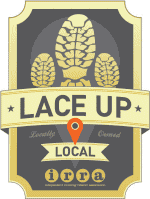
121 West Campbell St., Downtown Arlington Heights, IL 60005 | Tel. 847-670-9255
Business Hours : Monday - Friday 10:00 - 7:00 | Saturday 10:00 -5:00 | Closed on Sunday
Understanding the Basics of Foot Type and Running Shoe
A running shoe is designed to cradle the foot, and not just protect it from the pounding, but to optimize a runner's gait in such a way that a person can run longer and faster without worrying about injury. At its most basic, a running shoe is made up of an outsole, midsole and upper. The outsole is the bottom of the shoe, that durable slab of rubber providing traction throughout the gait cycle. The midsole rests atop the outsole, and provides cushioning and stability. The upper is generally made of mesh, synthetic fabrics or leather, and cocoons the foot.
Just as every run is unique, so every running shoe is designed for a specific type of runner. When selecting a running shoe, take into account the frequency of your training and your performance level. A shoe should fit comfortably and snug, but should not be so tight that your toes press against the front of the shoe or the top of your foot aches from the laces being too tight. If you run a great deal, it might be a good idea to look for a shoe that features the cushioning system in the heel and forefoot.
Also, be aware of your gait. The three broad categories that define running shoes -- Cushioning, Structured Cushioning, and Maximum Support -- enhance gait by working with the natural movement of your foot, providing a more efficient stride. How you pronate plays a great part in a shoe's ability to enhance your running experience.
Pronation is a normal, natural rolling motion that helps to attenuate shock. Some runners find that their foot does not roll all the way in, making the foot work harder to push off properly. This is known as underpronation (or supination). Conversely, a foot that rolls inward too much in known as overpronation. Runners who underpronate (or, supinate) would feel more comfortable with a Cushioning shoe. Overpronators do better with Maximum Support, and those with a more neutral stride would do well with Structured Cushioning.
Find your foot type
Foot Type and Shoe Fitting



High Arch
A high-arched foot is also known as an under-pronated foot. A runner with under-pronating feet is more likely to experience shock transmission through the lower legs, and should choose shoes from the Cushioning Category or those shoes that meet the needs of Under Pronating to Neutral runners.
Normal Arch
Runners with normal arches typically experience minimal biomechanical problems and should select those shoes from the Structured Cushioning Category or those shoes that meet the needs of the Neutral to Over Pronating runners.
Flat Foot
Flat-footed runners tend to have over-pronating feet, which generally result in poor natural shock absorption. These runners should pick shoes from the Maximum Support Category or those shoes that meet the needs of Over Pronating to Severe Over Pronating runners.
Finding the right fit shoes can be challenging. Our fit process also includes the analysis of your walk/run mechanic.
Through our shoe fitting experience, using the information about your foot type alone shares only a small part of gait analysis.
We know that, in many cases, people who have flat feet do not need motion control shoes if they don't pronate at all. We put focus on the mechanic of your hip, knee, ankle, arch and foot in order to recommend the correct type of footwear for you.
If you are looking for a great fitting pair of shoes whether for running, walking, exercising or just kick around, please come see us at Runners High 'n Tri.


